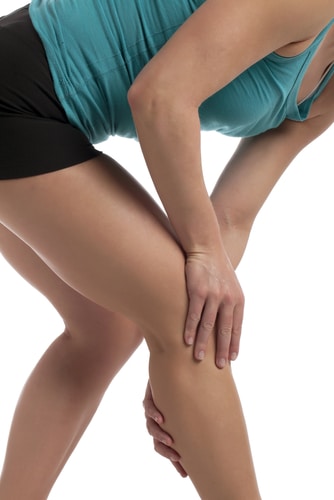
What Causes Calf Tightness?
There are two major muscles in your calves – the gastrocnemius muscle and the soleus muscle. There’s also a smaller muscle called the plantaris. The gastrocnemius muscle is the one that’s most visible when you stand on tippy toes while the soleus muscle lies a bit deeper. The soleus muscle is an important postural muscle that helps you maintain an upright position when you stand.
What do these muscles do? You use the soleus and gastrocnemius muscles to lift your heel up when walking or running and to stand on your tip-toes or jump. The Achilles tendon attaches these muscles to your heel and it’s susceptible to injury and strain, particularly when your calf muscles are tight. Some people are more prone towards calf tightness than others based on genetic variations in the way their gastrocnemius and soleus muscles are constructed.
For Some Women, High Heels Are the Culprit
If you walk around in high heels much of the time, the muscles in your calves shorten due to your heels being constantly raised. This shortening causes tension in the Achilles tendon that connects your calf muscles to your heels. In some cases, the shortened tendon can become inflamed leading to Achilles tendonitis. In other cases, you can experience calf tightness that makes it uncomfortable to walk or run.
There’s another drawback to tight calf muscles. They increase our risk of injury. That’s because tight calves tear more easily and create muscle imbalances that make injury more likely. Here’s a sobering thought. Calf muscle shortening from wearing high heels can be permanent. That means chronic problems with calf tightness and discomfort when you walk around or exercise. Might be better to give the heels a rest, huh?
Another culprit? Sitting too much. When you sit in a chair for long periods of time, your calf muscles shorten. This can make tight calves feel even tighter. So it may be more than your workout program or bad genetics that’s making your calves feel tight, you may be spending too much time sitting in front of your computer and walking around in heels.
Why Does Exercise Cause Tight Calves?
When you send too much neural stimulation to your gastrocnemius and soleus muscle group through exercise, they can tighten up, leading to that uncomfortable sensation of tightness you feel in your calves when you step out of bed in the morning. This also happens when you overwork your calf muscles by running, particularly running uphill, or jumping. Calf tightness can also lead to weakness of the opposing muscle group, the tibialis group of muscles. This creates a muscle imbalance.
If you have calf tightness, you may have other muscle imbalances as well. For example, you may have tight hamstring muscles since your calf muscles and hamstrings work together to help you get around. You may also have weak core muscles since your leg muscles are forced to work harder when your core muscles aren’t as strong as they should be.
Less commonly, calf tightness is a sign of a more serious problem like compartment syndrome where your calf muscles enlarge and push against the sheath that surrounds them, causing them to feel tight or painful. This is a serious condition that needs medical attention. If you have significant pain, numbness or swelling in your calves, see a doctor right away.
What Can You Do About Calf Tightness?
The number one thing you can do to prevent tight calves is to stretch. If you’re not doing calf stretching exercises after your workouts, that’s part of the problem. It’s not just important to stretch your calves after a workout – you should do it every hour or two throughout the day if you sit a lot. Standing calf stretches with your hands placed against a wall work well. You can do these at the office or almost anywhere where you have access to a wall.
Another quick way to stretch your calves is to stand on a step with your heels hanging over the edge. Hold onto the rail and drop your heels down off of the step and hold this position for 30 seconds. You can also stretch your calves by sitting on the floor with your legs stretched straight out in front of you. Use your hands to grasp the balls of your feet and pull them toward you until you feel the stretch. Hold for 30 seconds. Don’t forget to stretch your hamstrings and hip flexors since tight hamstrings also contribute to calf tightness.
Use a Foam Roller for Self-Myofascial Release
You can buy a foam roller at most sporting goods stores and use it for self-myofascial release. Sit down on the floor with your legs stretched out in front of you. Place the roller underneath your knees. Lift your buttocks off the floor using your hands and roll the foam roller slowly down to the base of your calves. If you encounter tender points, hold the pressure there until the tension subsides. Doing this manipulates neuromuscular receptors that help the muscle relax. Do this regularly before a workout to decrease tightness and improve your flexibility and mobility. It’s usually best to do this right after a workout while your core temperature is still elevated.
The Bottom Line?
Begin a regular stretching program that focuses on your calf muscles and your hamstrings to prevent calf tightness after a workout. Use a foam roller to do self-myofascial release beforehand. Do calf stretches every one to two hours when you’re sitting or walking on your computer and do regular core-strengthening exercises. Finally, consider trading in those high heels for a flat pair of shoes. Save the stilettos for special occasions.
References:
National Academy of Sports Medicine.
Related Articles By Cathe:
Great Legs Start With Great Calves
Are Ankle and Hip Mobility Issues Making It Harder for You to Squat?
What Are the Best Exercises for Weak, Underdeveloped Calf Muscles?
Does Wearing High Heels Increase the Risk of Osteoarthritis?

